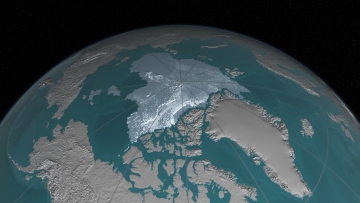720624_Atlantification_360 px width.jpg

Sea-ice levels in the Arctic are dependent on the patterns of high and low air pressure over Canada and Siberia. Credit: NASA Goddard
Conditions in the Arctic Ocean may be about to switch gears. That could mean that Arctic waters would become more like those in the North Atlantic—a process known as “atlantification.” As a result, sea ice would disappear a lot faster than it has in recent years.
The rate of sea-ice loss peaked in 2007. The total amount of ice is still going down, but much more slowly than it was before. In December of 2023, in fact, the sea ice increased at a higher rate than in all but two other months in the past 45 years.
A recent study said the slowdown in ice loss may be a result of the Arctic dipole—a pattern in the way air circulates over the far north. Today, there’s high pressure over the Canadian arctic, and low pressure over Siberia.
That pattern reduces the flow of warmer water from the North Atlantic Ocean into the Arctic Ocean. There’s a thicker layer of colder, fresher water at the top of the Arctic. That keeps the ice from vanishing as fast as expected based on the higher air temperatures produced by our warming climate.
Scientists looked at decades of observations made from ships, airplanes, and satellites. They found that the dipole might be about to flip over—from “positive” to “negative.” If that happens, the changing circulation in the atmosphere would allow more water to flow in from the Atlantic. That would warm the upper layers of the Arctic, causing sea ice to disappear much faster—boosting the “atlantification” of the Arctic.

